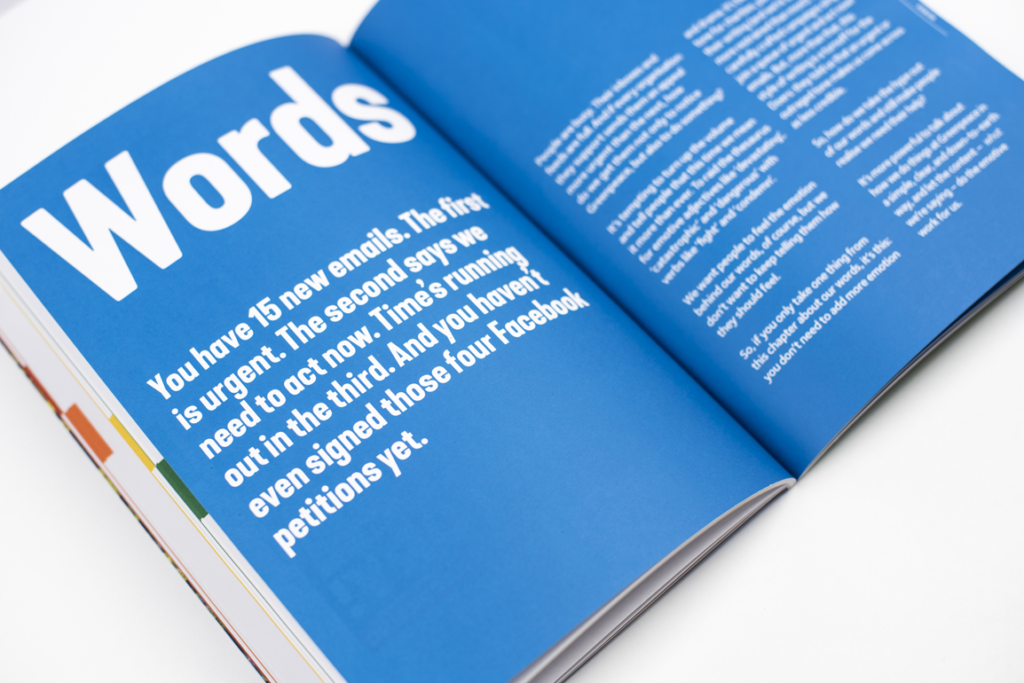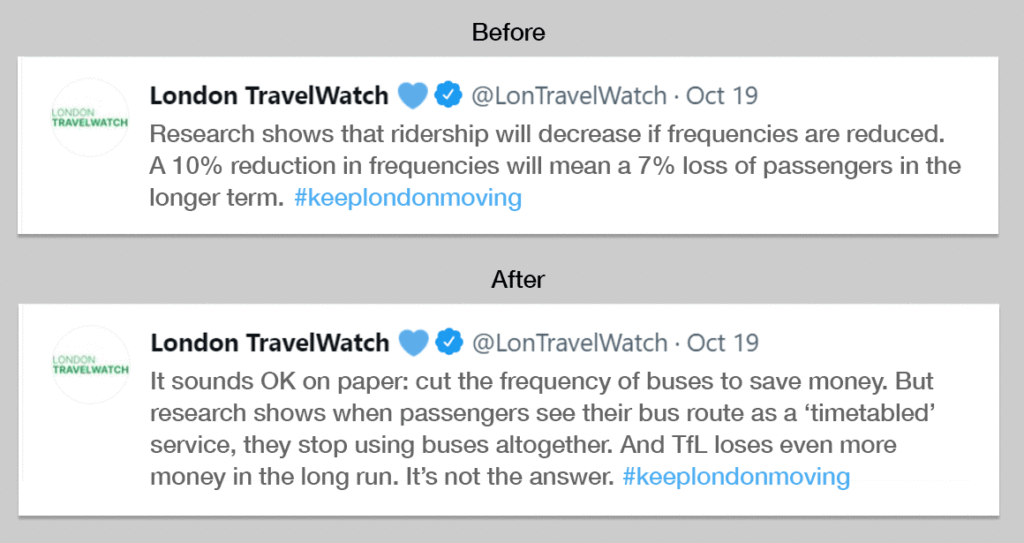“WHAT DO WE WANT?”
“JUSTICE… AND A SYSTEM-WIDE TRANSFORMATION IN OUR ECONOMY THAT EMPOWERS CITIZENS AS EFFECTIVE STEWARDS OF OUR FUTURE THROUGH CIRCULAR PRODUCTION, CONSUMPTION AND INVESTMENT PRACTICES, AND MANY OTHER CRITICAL SOLUTIONS.”
“WHEN DO WE WANT IT?”
“NOW!”
We’re going to need a bigger placard.
It used to be easy to write pithy, punchy slogans for an NGO (non-governmental organisation) or charity. Cancer Research stops cancer, Amnesty stands up for human rights, Greenpeace protects the environment. Now? Erm… It’s getting harder to pick apart which NGO/charity does what, or to sum up their work in a page or two, let alone a sentence.
Take UNICEF, the United Nations’ Children’s charity. They write: “the climate crisis is a child’s rights’ crisis”. And they’re not wrong: climate change affects everyone and everything, and causes poverty and homelessness among many other problems. But one NGO easily blurs with the next if everything’s presented around climate change alone. Then there are the thorny issues of identity and post-colonial guilt that come from most NGOs being unevenly concentrated in one half of the planet. Throw in lots of high-minded academic concepts and mangled bits of brand strategy and what have you got? A big knot. It’s not surprising everyone’s a bit lost.
Recently, we’ve been helping a bunch of NGOs untie the knots by writing about what they do with some well-chosen, non-NGO-sounding words. A lot of the issues we came across were similar. So put that vision, “theory of change”, “ambition statement”, key messages and those brand pillars to one side for a moment, and we’ll take you through some of the things we learned.
Nice to meet you, NGO. What do you do again?
1. LOFTY AIMS ARE TOO ABSTRACT TO BE USEFUL
It’s hard to whittle down what your NGO does to three or four things, let alone one. And yes, in theory, one way to do this is to simply sweep everything you do under a big concept like tackling “inequality”, or an academic theory like “rights-based education”. But when they’re that open ended, it becomes hard to know where your organisation’s work starts and stops, versus 90% of other NGOs who are tackling those things too. For these projects, we nearly always have to go back to basics and split apart what an NGO actually does (the bit that gets glossed over in ambition statements) from how it does them. And, most of all, we have to unpick everything and write the words long hand. If you distill things too soon (see step nine), you’ll get stuck in a long-running debate about “justice” vs “legitmacy” for the rest of your five-year strategy, while no-one will quite remember the point you were actually trying to make.
2. TONE DOWN THE DRAMA
When we worked for Greenpeace, we found supporters responded better to emails and petitions when we cut the alarmist language (eg “grave risk”, “decimated” and so on). You don’t need to cast oil companies or big tech as villains. It sounds counter-intuitive, but losing the drama makes the writing more hard-hitting. The plain facts and scale of the problems are stark enough, so toning down – not dumbing down – the language helps people focus on what we can all do to fix things.

3. CUT TO THE CHASE
No-one wants a three-page summary of the immense problems society faces, but we do want to know what your organisation is doing about them and where/how it fits. Keep your words pithy and headline-y, and make sure your pitch is front and centre. Snappily set out what you do overall at the start. And it’s a good discipline to organise everything you write around what you’re doing to make things better.
4. CONCENTRATE ON THE THINGS YOU CAN DIRECTLY CHANGE
Be specific: write about how you plan to change things rather than just presenting the problem or setting out some wishy-washy aims around it. Even protest movements like XR and Stop Oil need a “what next?” plan for what happens if (and when) their demands aren’t met. The classic case study here is Occupy, which ran out of steam because it couldn’t pin down what it was going to do next. That’s not to say you can’t have big ambitions – or be part of a bigger picture like Net Zero – but if your NGO seeks a more practical answer than outrage, at some point you’ll need to concentrate on specifics and your role in making them happen.
5. SINGLE OUT EXAMPLES OF WHAT YOU’RE DOING OR HAVE DONE
Sometimes it’s tricky to pin down or measure the impact of things and your part in making them happen. That’s OK if you’re clear and don’t fudge it or bundle everything under broad words like “advocacy”, which every NGO talks about. Be clear about what you did or what you were setting out to change (eg lobbying meetings about x behind the scenes, or drawing attention to biased algorithms), then be clear about where you’ve got to or where you want to get to. And if it’s hard to get there, clearly explain why.
6. LESS “NGO-Y” AND “WONKISH”
If you write about complex things using clear words, your writing won’t sound “dumbed down”. It’ll sound smart. Even a clued-up, policy-writing consultant would find it easier to read “We’ll put people whose lives are most affected by climate change first” or the snappier “Climate change isn’t fair”, than “elevating the needs and demands of those disproportionately affected by climate change”. And write about strategic stuff more directly, ie instead of “four pillars” write something like “here are four ways we’ll do this” (or whatever makes sense).

7. DON’T NAME EVERYTHING!
One NGO we spoke to was tripping over so many labels, like the “fair and just corridor”, and names of the partners they were working with (eg the “Future Change Lab”), we couldn’t work out how everything fitted together. So, first off, sum up what you do without any names. Then decide where and how each part fits with the whole, and whether they even need a name. It sounds like a political nightmare on paper, but it works if you manage it. We got everyone in Amnesty Tech to sign up to the principle before we started working with them. It made things MUCH easier (for everyone!) and diffused any internal misunderstandings from the off. Finally, if you do name different teams/areas of work, ditch stodgy words like “accountability” and don’t copy everyone else (Labs are very popular now – these things come in waves).
8. UNPACK AND EXPLAIN
As well as names, there are lots of NGO phrases and buzzwords like “accelerate the power shift”, “driving change” and everything is “intersectional” these days. These phrases make writing stodgy and your organisation’s take gets lost. Writing about how you’ll make things happen longhand may well need more words or even a couple of sentences, but it will help people understand what you’re up against and what you’re doing about it.
WE LIKE, CLICK AND TICK WITHOUT QUESTIONING WHO WE'RE HANDING OUR DATA TO - AND WHY. That was our 'hook' or way in to write about Amnesty Tech's work, introduced here by Rasha Abdul-Rahim, director of Amnesty Tech.
9. AND ONLY WHEN YOU’VE DONE ALL THAT, CAN YOU MAKE YOUR PITCH CATCHY.
When we started working for Amnesty, their vision read like an essay and ran over a dozen prosaic pages. By the end, we had a snappy articulation (which helps them talk about what they do in everything from internal presentations to job ads). We’ve nearly finished a similar project for Global Witness. But you can only get to that point if you put in the work and unpack the details: what fits, what doesn’t and how does it all come together? A lot of the reason branding exercises can feel like they’re going round in circles is they stay too high level and abstract. It’s easy to debate whether you need to include an adjective in a brand value but lose sight of the main things you want to start doing!
10. GET SOMEONE TO OWN THE DRAFTS
Another reason NGO and charity stuff is so hard to manage is that most organisations have flat hierarchies and there are a lot of views and competing priorities. Which is why one person needs to own the words and make a call. But we usually find that the process of working through what to say (and how) highlights repetition and shows how to make your pitch tighter. When the writing’s sharp and the thinking’s clear and pinned down, it does more than set direction or improve comms. It brings internal unity and irons out any disagreements too.
